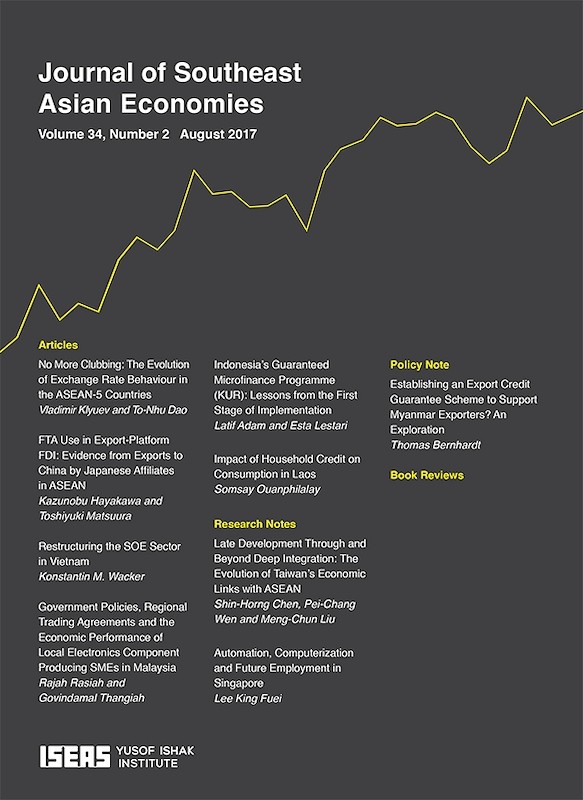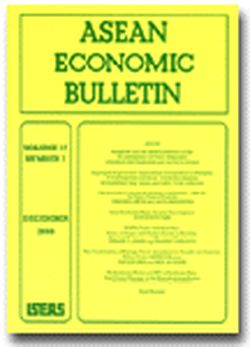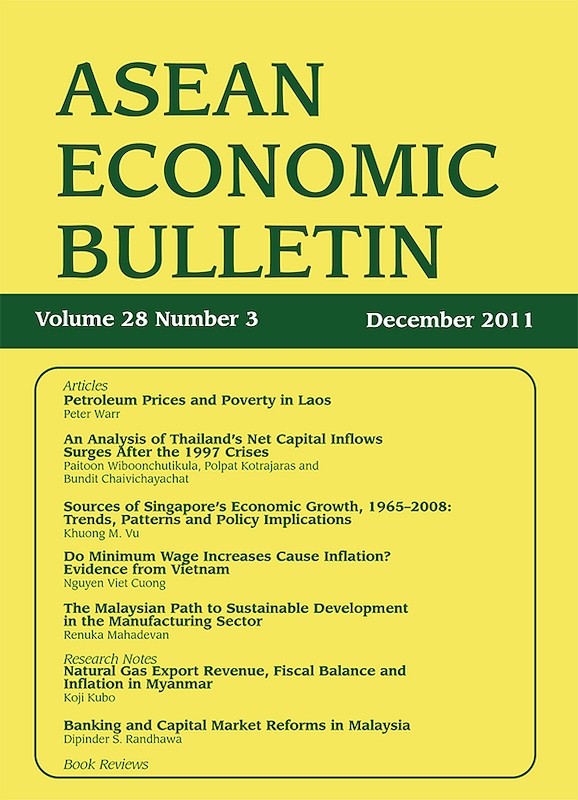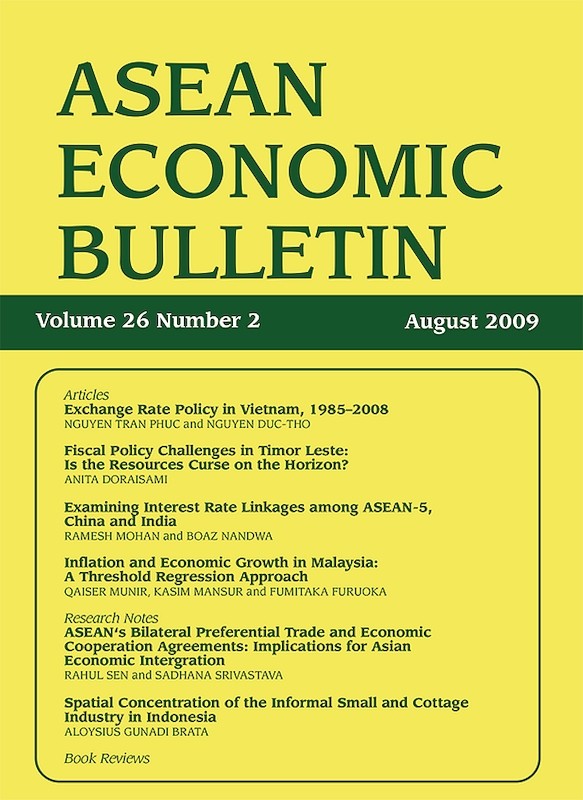ASEAN Economic Bulletin Vol. 20/2 (Aug 2003)

Date of publication:
August 2003
Number of pages:
96
Code:
AE20/2
Contents
-
ASEAN Economic Bulletin Vol. 20, no. 2 (Aug 2003)
-
Preliminary pages
- ARTICLES
-
Economic Integration between China and the ASEAN-5, by James Laurenceson, author see abstractThe current level of economic integration between China and ASEAN will largely determine the scale of the impact of China's WTO entry and the China-ASEAN free trade agreement. This article supplements volume-based measures of real and financial integration between China and the ASEAN-5 with those based on the international parity conditions. The results indicate that China's integration with the ASEAN-5 is already relatively advanced with respect to goods and services markets. Financial market integration however remains significantly incomplete. The main implication of this finding is that the impact of future liberalization will be felt most acutely in financial markets. This makes reforms complimentary to greater levels of external financial liberalization, such as regulatory reforms aimed at improving the risk management practices of financial institutions, matters of urgency for both China and the ASEAN-5.
-
Measuring Economy-wide Impacts of a Financial Shock, by Iwan J. Azis, Yuri Mansury, authors see abstractThis article analyses the transmission of financial shock to household income distribution using the case of Indonesia. Presumably, those benefiting from currency depreciation and high interest rate during the crisis are the high-income groups. However, the same groups might lose since they were employed in sectors that are highly import-dependent. On the production side, construction was the hardest-hit sector during the crisis, and thus the low-income non-agricultural households were more susceptible due to their heavy reliance on manual work in construction. This sector also proves to be instrumental in transmitting the shock from the credit crunch to the fall in household income. To the extent that a formal social safety net is lacking, an informal system of inter-household network is expected to mitigate the impact on the poor. However, we found that there is no convincing evidence that households acted altruistically to assist their distressed neighbours during the crisis.
-
Current Account Reversal during a Currency Crisis: The Malaysian Experience, by Gan Wee Beng, Soon Lee Ying, authors see abstractThis article is a case study of Malaysia's experience with a large-scale current account reversal following the outbreak of the East Asian financial crisis. The analysis focuses on the timing and magnitude of the shifts in the crucial macroeconomic variables that were required to effect the transfer of resources out of the economy following the outflows of portfolio capital. This is followed by an econometric evaluation of the response of the current account to macroeconomic shocks using structural vector auto-regression analysis. The SVAR analysis confirms that the current account adjustment was largely accomplished through the depreciation of the exchange rate and to a lesser extent the slowdown in real income growth.
-
Determinants of Supply of Non-Oil Exports in Brunei Darussalam, by Kwabena A Anaman, Tuty H Mahmod, authors see abstractThis article analyses factors influencing exports of non-oil products from Brunei Darussalam over a forty-year period from 1961 to 2000. The period covered transformation of Brunei from a low-income agriculture-based country to a high-income modern state with oil and gas production as the main engine of economic growth. The analysis employs a relatively new co-integration technique to identify the significant factors affecting levels of non-oil exports. The results indicate that real wages, level of oil exports as a proportion of gross domestic product, government exports promotion policy, and trend factors, such as improvement in infrastructure, significantly influenced long-run non-oil exports. Short-run disturbances to non-oil exports were driven by export prices, wage rates, government export promotion policy, and trend factors.
-
Total Factor Productivity Growth of Industrial State-owned Enterprises in Vietnam, 1976-98, by Vu Quoc Ngu, author see abstractVietnam has witnessed a relatively high rate of economic growth since the launch of its comprehensive economic reform under Doi Moi. Adding to that impressive achievement is the remarkable growth rate of the industrial sector, in which state-owned enterprises (SOEs) has accounted for nearly half of the output. The achievements have generally been attributed to different reform measures applied in the SOE sector in Vietnam from the early 1980s. This article reviews the SOE reform process in Vietnam and empirically assesses the total factor productivity (TFP) growth of the industrial SOEs for the 1976-98 period. The results show that the average annual TFP growth rate was 3.05 per cent over the whole study period and 4.22 and 5.37 per cent during the partial and full reform periods, respectively. For the whole study period, TFP accounts, on average, for 40.9 per cent of the change in industrial SOE output. In spite of these achievements, many problems remain, which need to be addressed for the ongoing SOE reform process in Vietnam.
-
RESEARCH NOTES: U.S.-Singapore Free Trade Agreement: Implications for ASEAN, by Jose L Tongzon, author
-
RESEARCH NOTES: The India-Singapore Comprehensive Economic Co-operation Agreement (CECA): A Good Beginning Towards an Enduring Economic Relationship, by Rahul Sen, author
-
BOOK REVIEW: India-ASEAN Partnership in an Era of Globalization, by Research and Information System for the Non-Aligned and Other Developing Countries (RIS), by Mukul G Asher, author
-
BOOK REVIEW: Japan and China: Cooperation, Competition and Conflict, edited by Hanns Gunther Hilpert and Ren Haak., by Shigeyuki Abe, author
-
BOOK REVIEW:Chinas Economy into the New Century: Structural Issues and Problems, edited by John Wong and Lu Ding., by Robert L Curry, Jr., author
-
BOOK REVIEW: Globalization and SMEs in East Asia, edited by Charles Harvie and Boon-Chye Lee., by Aegean Leung, author
-
BOOK REVIEW: Globalization and the Quality of Foreign Direct Investment, by Nagesh Kumar., by Sadhana Srivastava, author






